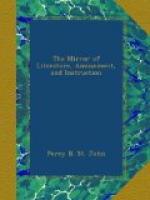* * * * *
BIRDS’ NESTS.
The structure of the nests of birds affords, perhaps, one of the most agreeable lessons in Natural History.
Among the most curious nests of our English birds may be named that of the Wren, the long-tailed Titmouse, the Thrush, the Goldfinch, the Chaffinch, the Magpie, and the House Sparrow; to these may also be added the Swallow’s, the Martin’s, the Wood Pigeon’s, and the Wood-Pecker’s. Of the nests of Rooks, it may be sufficient to observe, that they are often found to the number of six, or even more in a cluster. Crows’ nests are always solitary; they are similar in structure to those of the rook.
Among the nests of Foreign birds, that of the Taylor Bird deserves especial mention; the bird itself is a diminutive one, being little more than three inches long; it is an inhabitant of India. The nest is sometimes constructed of two leaves, one of them dead; the latter is fixed to the living one as it hangs upon the tree, by sewing both together in the manner of a pouch or purse; it is open at the top, and the cavity is filled with fine down; and, being suspended from the branch, the birds are secure from the depredations of snakes and monkeys, to which they might otherwise fall a prey.
In Dr. Latham’s collection is a specimen of the taylor bird’s nest, composed of a single large leaf, of a fibrous rough, texture, about six inches long independent of the stalk, five inches and a half in breadth, and ending in a point. The sides of this leaf are drawn together so as to meet within three-quarters of an inch; within is the nest, about four inches deep and two broad, opening at the top; the bottom of the leaf is drawn upwards, to assist in the support of it. The interior nest is composed of white down, with here and there a feather and a small portion of white down intermixed.
Another nest of this bird has also been described as composed of several leaves, like those of some kind of hazel sewed together; the inner nest formed of dry bents, fibres, and hairs, suspended from a tree. It is, therefore, probable that this bird, as well as some others, varies the structure of its nest as occasion and the materials may require. These singular works are performed by the bird’s using his bill instead of a needle, and vegetable fibres for thread.
The Rufous Bee-eater, or Merops Rufus, constructs also a very singular nest. This bird is a native of Buenos Ayres; the nest is built generally on the naked great branch of a tree, sometimes on the windows of houses, a fence, or a projecting beam of a high house or other building; it is composed of earth, in the form of a baker’s oven, and is often built in the short space of two days, both birds being engaged in its construction; it is six inches in diameter, and one thick; a division is within, beginning at the entrance, and carried circularly, so that the eggs are deposited in the inner chamber, on a bed of grass. The swallow and other birds often attempt to obtain possession of this nest, but are generally repulsed by the owners.




